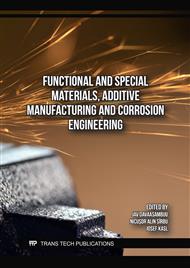[1]
J. K. Han, G. Naren, A. Bohnuud, et al. Study on the structural and photophysical properties of N-acyl amino acid europium complexes. Arabian Journal of Chemistry, 16(2023)10524-6.
DOI: 10.1016/j.arabjc.2023.105246
Google Scholar
[2]
C. Archana, L. Ritu. Preparation, characterization and luminescence behavior of some samarium complexes. Rare Metals, 40(2021)2618.
DOI: 10.1007/s12598-020-01552-9
Google Scholar
[3]
G. Naren, T. Bao, J. Ning, et al. Optical properties and aggregation behavior of environmentally friendly Lanthanum (III) acyl-alaninnate complexes. Arabian Journal of Chemistry, 13(2020)5864.
DOI: 10.1016/j.arabjc.2020.04.023
Google Scholar
[4]
V. P. Shtefanets, G. V. Shilov, E. I. Kunitsyna, et al. Rare-Earth Metal (Pr(III), Tb(III), Ho(III), and Er(III)) Complexes with 2-Mercaptopyridine-N-oxide: Synthesis, Structures, and Properties. Russian Journal of Coordination Chemistry, 48(2022)436-451.
DOI: 10.1134/s1070328422070089
Google Scholar
[5]
K. Katarzyna, O. Grażyna. Synthesis, crystal structure and optical properties of new (Nd, Sm) and other lanthanide (Ln = Pr) complexes with 1,10-phenanthroline and thiocyanate. Polyhedron, 146 (2018)145-153.
DOI: 10.1016/j.poly.2018.03.004
Google Scholar
[6]
M. H. Cui, L. P. Yang, F. C. Li, et al. Multifunctional DyIII Enantiomeric Pairs Showing Enhanced Photoluminescences and Third-Harmonic Generation Responses through the Coordination Role of Homochiral Tridentate N,N,N-Pincer Ligands. Inorganic chemistry, 60(2021)13366-13375.
DOI: 10.1021/acs.inorgchem.1c01682.s001
Google Scholar
[7]
Y. Zhang, G. Naren, T. Bao, et al. Synthesis, Characterization, and DFT studies of Praseodymium (III) Octanoyl-DL-aminocarb oxylate Complexes. Chemistry Select, 7(2022) e202104100.
DOI: 10.1002/slct.202104100
Google Scholar
[8]
V. Gowda, B. Sarma, S. Öberg, et al. Structure Elucidation of an Yttrium Diethyldithiocarbamato-Phenanthroline Complex by X-ray Crystallography, Solid-State NMR, and ab-initio Quantum Chem-ical Calculations. European Journal of Inorganic Chemistry, 2016(2016)3278-3291.
DOI: 10.1002/ejic.201600059
Google Scholar
[9]
X. Liu, Y. Zhang, X. M. Pan, et al. Rare earth cerium-phenanthroline binary complex as a new corrosion inhibitor for carbon steel in acidic medium. Research on Chemical Intermediates, 49 (2022)1235-1257.
DOI: 10.1007/s11164-022-04918-z
Google Scholar
[10]
Y. j. Chen, S. N. Wu, Z. F. Xing, et al. Synthesis, structural characterization and luminescent properties of a novel europium ternary complex Eu(2-A-4-CBA)3 phen. Journal of Alloys and Com-pounds, 649(2015)699-703.
DOI: 10.1016/j.jallcom.2015.03.137
Google Scholar
[11]
Y. H. Xiao, Z. P. Deng, Z. B. Zhu, et al. Rare earth metal-organic complexes constructed from hydroxyl and carboxyl modified arenesulfonate: syntheses, structure evolutions, and ultraviolet, visi-ble and near-infrared luminescence. Dalton transactions, 46(2017) 16493-16504.
DOI: 10.1039/c7dt03254d
Google Scholar
[12]
Z. Ahmed, K Iftikhar. Sensitization of visible and NIR emitting lanthanide(III) ions in noncent-rosym-metric complexes of hexafluoroacetylacetone and unsubstituted monodentate pyrazole. The journal of physical chemistry, 117(2013)11183-11201.
DOI: 10.1021/jp403668j
Google Scholar
[13]
K. Zheng, Z. Q. Liu, Y. Huang, et al. Highly luminescent Ln-MOFs based on 1,3-adamanta-nediacetic acid as bifunctional sensor. Sensors & Actuators: B. Chemical, 257(2018) 705-713.
DOI: 10.1016/j.snb.2017.11.009
Google Scholar
[14]
M.T. Metlin, S.A. Ambrozevich, D.A. Metlina, et al. Luminescence of pyrazolic 1, 3-diketone Pr3+ complex with 1, 10-phenanthroline. Journal of Luminescence, 188(2017)365.
DOI: 10.1016/j.jlumin.2017.04.058
Google Scholar
[15]
X. G. Mu, Y. h. Zhang, L. N. Wang, et al. A family of coordination polymers derived from a flexible dicarboxylic acid and auxiliary N-donor ligands: solvothermal synthesis, crystal structure and dye adsorption properties. Transition Metal Chemistry, 46(2021)219-230.
DOI: 10.1007/s11243-020-00438-0
Google Scholar


